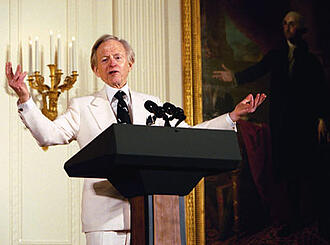In the 1880s, the term "new journalism" was sometimes used to refer to the new yellow print newspapers that were being popularized at the time. In 1923, Robert E. Park referred to the penny-newspaper trend of the 1830s as the advent of "new journalism." In 1973, Bonfire of the Vanities (1987) author Tom Wolfe edited an anthology containing works by Truman Capote, Norman Mailer, and Joan Didion, fashioned as both a collection of admirable pieces of writing and as a sort of manifesto for what Wolfe saw as the a groundbreaking trend in American letters. Its title? The New Journalism. Third time’s the charm.
 Though Tom Wolfe was clearly not the first person to dub something "new journalism," his meaning of the phrase is what we most typically lean on today. It was, and no doubt still is, Wolfe’s contention that American novels were dead or dying, and that it was for journalism to replace them. Not just any journalism would do, of course. Wolfe called for a style of investigative report that borrowed techniques from literary fiction (especially those employed by social realists like Emile Zola and Charles Dickens) to bring factually accurate scenes to life, thereby bridging the gap between reader and writer with more depth and emotional honesty. In particular, Wolfe called for the use of scene construction, point of view, and third person narration focused on an identifiable protagonist to the end of creating non-fiction pieces that read more like novels. Wolfe’s own books, like The Electric Kool-Aid Acid Test (1968) employed these very same techniques to great acclaim.
Though Tom Wolfe was clearly not the first person to dub something "new journalism," his meaning of the phrase is what we most typically lean on today. It was, and no doubt still is, Wolfe’s contention that American novels were dead or dying, and that it was for journalism to replace them. Not just any journalism would do, of course. Wolfe called for a style of investigative report that borrowed techniques from literary fiction (especially those employed by social realists like Emile Zola and Charles Dickens) to bring factually accurate scenes to life, thereby bridging the gap between reader and writer with more depth and emotional honesty. In particular, Wolfe called for the use of scene construction, point of view, and third person narration focused on an identifiable protagonist to the end of creating non-fiction pieces that read more like novels. Wolfe’s own books, like The Electric Kool-Aid Acid Test (1968) employed these very same techniques to great acclaim.
There is, of course, something paradoxical about Wolfe’s vision for the New Journalism. In the Gonzo Journalism of Hunter S. Thompson (himself often cited as a father of New Journalism), reporters included themselves in their pieces to acknowledge the subjective view that necessarily guides any account, no matter how traditionally journalistic. In Wolfe’s view, on the other hand, subjectivity wasn’t a necessary evil, but actually a gateway to increased objectivity. More than that, there is something inherently perplexing about a movement that purports that the novel is dead while insisting on borrowing its stylistic milieu.
 That the New Journalism as Wolfe lays it out is hard to pin down does not, however, speak to its failings as a genre. Rather, it signals the very reality which made the New Journalism necessary to begin with. It’s crucial to remember that Wolfe’s tract was, in 1973, already retrospective. It attempted to describe the groundbreaking work already being done by Gay Talese, Joan Didion, and company. The use of fictive elements by this highly regarded cadre of wordsmiths speaks to the difficulty inherent in conveying an accurate sense of real-world events. Although Wolfe’s explanation of this phenomenon seems to suffer from some confusion, it speaks clearly to that very difficulty which makes his own longer writing necessary.
That the New Journalism as Wolfe lays it out is hard to pin down does not, however, speak to its failings as a genre. Rather, it signals the very reality which made the New Journalism necessary to begin with. It’s crucial to remember that Wolfe’s tract was, in 1973, already retrospective. It attempted to describe the groundbreaking work already being done by Gay Talese, Joan Didion, and company. The use of fictive elements by this highly regarded cadre of wordsmiths speaks to the difficulty inherent in conveying an accurate sense of real-world events. Although Wolfe’s explanation of this phenomenon seems to suffer from some confusion, it speaks clearly to that very difficulty which makes his own longer writing necessary.
And that necessity, however we try to define it, has led to the creation of some of the best-loved writing of the past sixty years. Joan Didion, for instance, achieved great acclaim with relatively early works like Slouching Toward Bethlehem (1968) and The White Album (1979) and continued to make waves with later works like Where I Was From (2003) and The Year of Magical Thinking (2005), the latter of which has had a profound impact on the increasingly popular world of literary memoirs. Meanwhile, Breakfast at Tiffany's (1958) author Truman Capote’s In Cold Blood (1965), which he described as a non-fiction novel, has been a staple of top-novel lists and college syllabi for years. Whatever they were as a group, as individuals these authors stand as some of the strongest voices of their generation.









